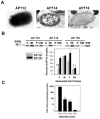Partially assembled K99 fimbriae are required for protection
- PMID: 16239523
- PMCID: PMC1273889
- DOI: 10.1128/IAI.73.11.7274-7280.2005
Partially assembled K99 fimbriae are required for protection
Abstract
Antibodies to K99 fimbriae afford protection to F5+ bovine enterotoxigenic Escherichia coli (ETEC). Previous studies show that murine dams immunized with Salmonella vaccine vectors stably expressing K99 fimbriae confer protection to ETEC-challenged neonatal pups. To begin to address adaptation of the K99 scaffold to display heterologous B- and T-cell epitopes, studies were conducted to determine how much of the assembled K99 fimbria is required to maintain protective immunity. Sequential deletions in the K99 gene clusters were made, resulting in diminished localization of the K99 fimbrial subunit in the outer membrane. As placement of the K99 fimbrial subunit became progressively contained within the vaccine vector, diminished immunoglobulin A (IgA) and IgG1 antibody titers, as well as diminished Th2-type cytokine responses, were observed in orally immunized mice. Deletion of fanGH, which greatly reduced the export of the fimbrial subunit to the outer membrane, showed only partial reduction in protective immunity. By contrast, deletion of fanDEFGH, which also reduced the export of the fimbrial subunit to the outer membrane but retained more subunit in the cytoplasm, resulted in protective immunity being dramatically reduced. Thus, these studies showed that retention of K99 fimbrial subunit as native fimbriae or with the deletion of fanGH is sufficient to confer protection.
Figures




Similar articles
-
Oral immunization with a Salmonella typhimurium vaccine vector expressing recombinant enterotoxigenic Escherichia coli K99 fimbriae elicits elevated antibody titers for protective immunity.Infect Immun. 1998 Nov;66(11):5470-6. doi: 10.1128/IAI.66.11.5470-5476.1998. Infect Immun. 1998. PMID: 9784559 Free PMC article.
-
Immunization with recombinant Lactobacillus casei strains producing K99, K88 fimbrial protein protects mice against enterotoxigenic Escherichia coli.Vaccine. 2012 May 9;30(22):3339-49. doi: 10.1016/j.vaccine.2011.08.036. Epub 2011 Aug 19. Vaccine. 2012. PMID: 21856357
-
Epitope analysis of the FanC subunit protein of the K99 (F5) fimbriae of enterotoxigenic Escherichia coli using a recombinant fusion technique.FEMS Immunol Med Microbiol. 2002 Sep 6;34(1):23-31. doi: 10.1111/j.1574-695X.2002.tb00599.x. FEMS Immunol Med Microbiol. 2002. PMID: 12208603
-
F4 fimbriae expressed by porcine enterotoxigenic Escherichia coli, an example of an eccentric fimbrial system?J Mol Microbiol Biotechnol. 2004;7(4):155-69. doi: 10.1159/000079825. J Mol Microbiol Biotechnol. 2004. PMID: 15383714 Review.
-
Fimbrial surface display systems in bacteria: from vaccines to random libraries.Microbiology (Reading). 2000 Dec;146 Pt 12:3025-3032. doi: 10.1099/00221287-146-12-3025. Microbiology (Reading). 2000. PMID: 11101660 Review. No abstract available.
Cited by
-
Probiotic engineering: towards development of robust probiotic strains with enhanced functional properties and for targeted control of enteric pathogens.Gut Pathog. 2017 May 8;9:28. doi: 10.1186/s13099-017-0178-9. eCollection 2017. Gut Pathog. 2017. PMID: 28491143 Free PMC article. Review.
-
IL-13 production by regulatory T cells protects against experimental autoimmune encephalomyelitis independently of autoantigen.J Immunol. 2008 Jul 15;181(2):954-68. doi: 10.4049/jimmunol.181.2.954. J Immunol. 2008. PMID: 18606647 Free PMC article.
-
Animal Enterotoxigenic Escherichia coli.EcoSal Plus. 2016 Oct;7(1):10.1128/ecosalplus.ESP-0006-2016. doi: 10.1128/ecosalplus.ESP-0006-2016. EcoSal Plus. 2016. PMID: 27735786 Free PMC article. Review.
-
Tolerance in the absence of autoantigen.Endocr Metab Immune Disord Drug Targets. 2007 Sep;7(3):203-10. doi: 10.2174/187153007781662549. Endocr Metab Immune Disord Drug Targets. 2007. PMID: 17897047 Free PMC article. Review.
-
Vaccination without autoantigen protects against collagen II-induced arthritis via immune deviation and regulatory T cells.J Immunol. 2008 Aug 15;181(4):2741-52. doi: 10.4049/jimmunol.181.4.2741. J Immunol. 2008. PMID: 18684965 Free PMC article.
References
-
- Bayer, M., K. Bischof, R. Noiges, and G. Koraimann. 2000. Subcellular localization and processing of the lytic transglycosylase of the conjugative plasmid R1. FEBS Lett. 466:389-393. - PubMed
-
- Black, R. E. 1992. Epidemiology of diarrhoeal disease: implications for control by vaccines. Vaccine 11:100-106. - PubMed
-
- Chatfield, S. N., I. G. Charles, A. J. Makoff, M. D. Oxer, G. Dougan, D. Pickard, D. Slater, and N. F. Fairweather. 1992. Use of the nirB promoter to direct the stable expression of heterologous antigens in Salmonella oral vaccine strains: development of a single-dose oral tetanus vaccine. Biotechnology (N.Y.) 10:888-892. - PubMed
Publication types
MeSH terms
Substances
Grants and funding
LinkOut - more resources
Full Text Sources
Medical
Research Materials
Miscellaneous

